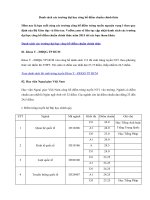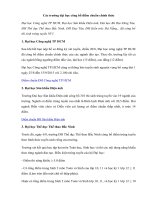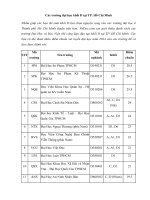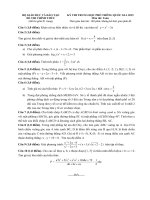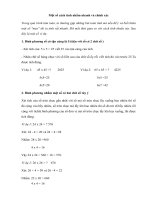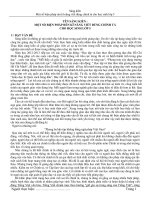Accounting26th ch 23
Bạn đang xem bản rút gọn của tài liệu. Xem và tải ngay bản đầy đủ của tài liệu tại đây (1014.6 KB, 33 trang )
CHAPTER
23
Performance Evaluation
Using Variances from
Standard Costs
Warren
Reeve
Duchac
©2016
human/iStock/360/Getty Images
Accounting
26e
Standards
(slide 1 of 2)
•
•
Standards are performance goals.
Manufacturing companies normally use standard cost
for each of the three following product costs:
o
o
o
Direct materials
Direct labor
Factory overhead
©2016
Standards
(slide 2 of 2)
•
Accounting systems that use standards for product
costs are called standard cost systems.
o
Standard cost systems enable management to determine
the following:
How much a product should cost (standard cost)
How much it does cost (actual cost)
•
When actual costs are compared with standard costs,
the exceptions or variances are reported.
o
This reporting by the principle of exceptions allows
management to focus on correcting the cost variances.
©2016
Setting Standards
•
The standard-setting process normally requires the
joint efforts of accountants, engineers, and other
management personnel.
o
o
The accountant converts the results of judgments and process
studies into dollars and cents.
Engineers with the aid of operation managers identify the
materials, labor, and machine requirements needed to
produce the product.
©2016
Types of Standards
•
•
Ideal standards, or theoretical standards, are
standards that can be achieved only under perfect
operating conditions, such as no idle time, no machine
breakdowns, and no materials spoilage.
Currently attainable standards, sometimes called
normal standards, are standards that can be attained
with reasonable effort.
©2016
Criticisms of Standard Costs
•
Some criticisms of using standard costs for
performance evaluation include the following:
o
o
o
o
Standards limit operating improvements by discouraging
improvement beyond the standard.
Standards are too difficult to maintain in a dynamic
manufacturing environment, resulting in “stale standards.”
Standards can cause employees to lose sight of the larger
objectives of the organization by focusing only on efficiency
improvements.
Standards can cause employees to unduly focus on their
own operations to the possible harm of other operations
that rely on them.
©2016
Budgetary Performance Evaluation
(slide 1 of 2)
•
The budgetary performance evaluation compares the
actual performance against the budget.
o
The standards for direct materials, direct labor, and factory
overhead are separated into the following two components:
Standard price
Standard quantity
o
The standard cost per unit for direct materials, direct labor,
and factory overhead is computed as follows:
©2016
Budgetary Performance Evaluation
(slide 2 of 2)
•
The master budget is prepared based on planned
sales and production.
o
o
The budgeted costs for materials purchases, direct labor,
and factory overhead are determined by multiplying their
standard costs per unit by the planned level of production.
Budgeted (standard) costs are then compared to actual
costs during the year for control purposes.
©2016
Budget Performance Report
•
The differences between actual and standard costs
are called costs variances.
o
o
•
A favorable cost variance occurs when the actual cost is
less than the standard cost (at actual volumes).
An unfavorable cost variance occurs when the actual cost
exceeds the standard cost.
The report that summarizes actual costs, standard
costs, and the differences for the units produced is
called a budget performance report.
o
The budget performance report is based on actual
production rather than planned production.
©2016
Manufacturing Cost Variances
(slide 1 of 4)
•
•
The total manufacturing cost variance is the
difference between total standard costs and total
actual cost for the units produced.
For control purposes, each product cost variance is
separated into two additional variances.
©2016
Manufacturing Cost Variances
(slide 2 of 4)
•
The total direct materials variance is separated into a
price and quantity variance.
o
This is because standard and actual direct materials costs
are computed as follows:
Thus, the actual and standard direct materials costs may differ
because of a price difference (variance), a quantity difference
(variance), or both.
©2016
Manufacturing Cost Variances
(slide 3 of 4)
•
The total direct labor variance is separated into a
rate and a time variance.
o
This is because standard and actual direct labor costs are
computed as follows:
Therefore, the actual and standard direct labor costs may differ
because of a rate difference (variance), a time difference
(variance), or both.
©2016
Manufacturing Cost Variances
(slide 4 of 4)
•
The total factory overhead variance is separated into
a controllable variance and a volume variance.
o
Because factory overhead has fixed and variable cost
elements, it uses different variances than direct materials
and direct labor, which are variable costs.
©2016
Direct Materials Price Variance
•
The direct materials price variance is computed as
follows:
o
If the actual price per unit exceeds the standard price per
unit, the variance is unfavorable.
This positive amount (unfavorable variance) can be thought of as
increasing costs (a debit).
o
If the actual price per unit is less than the standard price
per unit, the variance is favorable.
This negative amount (favorable variance) can be thought of as
decreasing costs (a credit).
©2016
Direct Materials Quantity Variance
•
The direct materials quantity variance is computed as
follows:
o
If the actual quantity for the units produced exceeds the
standard quantity, the variance is unfavorable.
This positive amount (unfavorable variance) can be thought of as
increasing costs (a debit).
o
If the actual quantity for the units produced is less than the
standard quantity, the variance is favorable.
This negative amount (favorable variance) can be thought of as
decreasing costs (a credit).
©2016
Direct Labor Rate Variance
•
The direct labor rate variance is computed as follows:
o
If the actual rate per hour exceeds the standard rate per
hour, the variance is unfavorable.
This positive amount (unfavorable variance) can be thought of as
increasing costs (a debit).
o
If the actual rate per hour is less than the standard rate per
hour, the variance is favorable.
This negative amount (favorable variance) can be thought of as
decreasing costs (a credit).
©2016
Direct Labor Time Variance
•
The direct labor time variance is computed as follows:
o
If the actual direct labor hours for the units produced
exceeds the standard direct labor hours, the variance is
unfavorable.
This positive amount (unfavorable variance) can be thought of as
increasing costs (a debit).
o
If the actual direct labor hours for the units produced is less
than the standard direct labor hours, the variance is
favorable.
This negative amount (favorable variance) can be thought of as
decreasing costs (a credit).
©2016
Factory Overhead Variances
•
Factory overhead costs are analyzed differently than
direct labor and materials costs.
o
•
This is because factory overhead costs have fixed and
variable cost elements.
Factory overhead costs are budgeted and controlled
by separating factory overhead into fixed and
variable components.
o
Doing so allows the preparation of flexible budgets and the
analysis of factory overhead controllable and volume
variances.
©2016
The Factory Overhead Flexible Budget
(slide 1 of 2)
•
The budgeted factory overhead rate for Western
Rider is computed as follows:
©2016
The Factory Overhead Flexible Budget
(slide 2 of 2)
•
For analysis purposes, the budgeted factory
overhead rate is subdivided into a variable factory
overhead rate and a fixed factory overhead rate.
For Western Rider, the variable overhead rate and
the fixed overhead rate are computed as follows:
©2016
Variable Factory Overhead
Controllable Variance
(slide 1 of 2)
•
•
The variable factory overhead controllable variance
is the difference between the actual variable
overhead costs and the budgeted variable overhead
for actual production.
The variable factory overhead controllable variance
is computed as follows:
o
o
If the actual variable overhead is less than the budgeted
variable overhead, the variance is favorable.
If the actual variable overhead exceeds the budgeted
variable overhead, the variance is unfavorable.
©2016
Variable Factory Overhead
Controllable Variance
(slide 2 of 2)
•
•
The budgeted variable factory overhead is the
standard variable overhead for the actual units
produced.
The budgeted variable factory overhead is computed
as follows:
©2016
Fixed Factory Overhead Volume Variance
•
•
The fixed factory overhead volume variance is the
difference between the budgeted fixed overhead at
100% of normal capacity and the standard fixed
overhead for the actual units produced.
The fixed factory overhead volume variance is
computed as follows:
©2016
Factory Overhead Cost Variance Report
©2016
Factory Overhead Account
(slide 1 of 3)
•
At the end of the period, the factory overhead
account normally has a balance.
o
A debit balance in Factory Overhead represents
underapplied overhead.
Underapplied overhead occurs when actual factory overhead costs
exceed the applied factory overhead.
o
A credit balance in Factory Overhead represents
overapplied overhead.
Overapplied overhead occurs when actual factory overhead costs
are less than the applied factory overhead.
©2016

